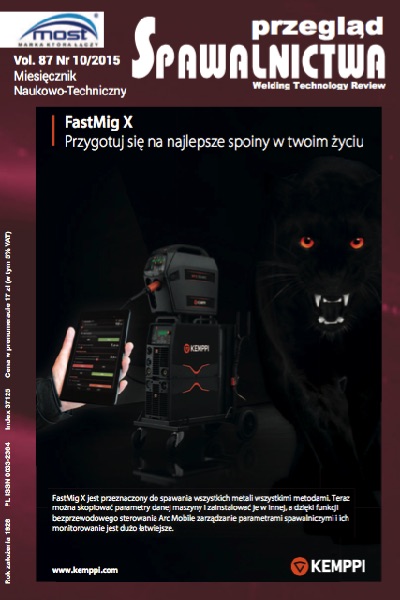Przemiany strukturalne stali S700MC w warunkach oddziaływania symulowanych cykli cieplnych spawania
Main Article Content
Abstract
Badania przemian strukturalnych stali S700MC w warunkach oddziaływania symulowanych cykli cieplnych spawania przeprowadzono na prototypowym stanowisku pomiarowym, w którym nagrzewanie badanych próbek odbywało się z wykorzystaniem lamp podczerwieni. Zakres badań obejmował: analizę kontrolną składu chemicznego stali S700MC wraz z zawartością azotu, badania wpływu cykli cieplnych na strukturę i twardość symulowanej strefy wpływu ciepła stali S700MC, wy- konanie wykresu przemian austenitu dla warunków spawalniczych CTPC-S, badania metalograficzne mikroskopowe i pomiary twardości próbek ze stali S700MC po symulacji w funkcji czasu chłodzenia t8/5. Metodyka badania przemian strukturalnych opierała się na jedno- czesnym wykorzystaniu trzech metod pomiarowych: metody dylatometrycznej, metody magnetometrycznej oraz metody analizy termicznej. W trakcie badania dokonano rejestracji trzech wielkości: dylatacji materiału próbki, zmiany strumienia magnetycznego oraz temperatury. Podczas badań przemian strukturalnych realizowano trzy rodzaje cykli cieplnych: cykle szybkie - realizowane z nadmuchem na próbkę gazu chłodzącego i ochronnego, cykle naturalne - realizowane ze swobodnym chłodzeniem próbki (włączony tylko przepływ gazu ochronnego), cykle wolne - realizowane z dogrzewaniem lampami w fazie chłodzenia próbki. Na podstawie badań przemian strukturalnych stali S700MC w warunkach oddziaływa- nia symulowanych warunków cieplnych wyznaczono wykres CTPc-S w zakresie czasu stygnięcia t8/5 od 2 do 200 s wraz z wykresem uzupełniającym rozkładu twardości w funkcji czasu chłodzenia oraz określono zmiany struk- turalne zachodzące w badanym materiale.
The study of structural changes in the TMCP S700MC
steel under the influence of simulated welding thermal cycles
Abstract
Structural transformation studies of S700MC steel were carried out using a prototype bench system, wherein the heating of the test samples was done using infrared lamps. The scope of the research included: chemical composition analysis of S700MC steel together with a nitrogen content, study of the effect of thermal cycles on the structure and hardness of the simulated heat affected zone of steel S700MC, plotting transformation of austenite to the welding conditions CTT, metallographic microscopy and hardness measurements of S700MC steel samples after the simulation as a function of the cooling time t8/5. Methodology of the structural changes study was based on the simultaneous use of three measurement methods: the dilatometric method, magnetometric method and the thermal analysis method. During the study, three parameters were recorded: dilation of the sample, the magnetic flux changes and temperature. During the structural changes study, three types of thermal cycles were used: fast cycles - implemented with blowing cooling and protective gas on sample, natural cycles - realized with the free cooling of the sample (only enabled the flow of protective gas), free cycles - implemented with additional heat lamps during the cooling phase of the sample (only enabled the flow of protective gas). During the study, the phase transformation critical temperatures were determined and transformation graph of austenite CCT for the welding conditions, with regard to cooling time t8/5 from 2 to 200 seconds with respect to the complementary graph of hardness distribution as a function of the cooling time and indicates structural changes in the material.
Downloads
Article Details
Creative Commons CC BY 4.0 https://creativecommons.org/licenses/by/4.0/
Welding Technology Review (WTR) articles are published open access under a CC BY licence (Creative Commons Attribution 4.0 International licence). The CC BY licence is the most open licence available and considered the industry 'gold standard' for open access; it is also preferred by many funders. This licence allows readers to copy and redistribute the material in any medium or format, and to alter, transform, or build upon the material, including for commercial use, providing the original author is credited.
References
Nishioka K., Ichikawa K.: Progress in termomechanical control of steel plates and their commercialization, Science and Technology of Advanced Materials, vol. 13, No. 2, April 2012, pp. 1-20.
Chen B., Yu H.: Hot ductility behaviour of V-N and V-Nb microalloyed steels, International Journal of Minerals, Metallurgy and Materials, vol. 19, No. 6, June 2012, p. 525.
Lee, H. Shin, K. Park: Evaluation of high strength TMCP steel weld for use in cold regions, Journal of Constructional Steel Research 74 (2012), pp. 134139.
Lisiecki A.: Diode laser welding of high yield steel. Proc. of SPIE Vol. 8703, Laser Technology 2012: Applications of Lasers, 87030S (January 22, 2013), DOI: 10.1117/12.2013429.
Górka J.: Własności i struktura złączy spawanych stali obrabianej termomechanicznie o wysokiej granicy plastyczności, Wydawnictwo Politechniki Śląskiej, Gliwice 2013.
Grajcar A., Różański M., Stano S.: Effect of heat input on microstructure and hardness distribution of laser welded Si-Al TRIP-type steel, Advances Material Science Engineering. 2014, Article ID 658947, pp. 1÷8.
Górka J.: Weldability of thermomechanically treated steels having a high yield point, Archives of Metallurgy and Materials, Volume 60, Issue 1/2015, pp. 469-475.
Górka J.: Changes in the structure and properties of the steel S700MC by heat treatment, Advanced Material Research, vol. 1036/2014, pp. 111-116.
Mikno Z., Grzesik B., Łomozik M., Zeman M., Pilarczyk A.: Opracowanie systemu metodyki pomiarowej w badaniach przemian strukturalnych w stalach, w warunkach cykli cieplnych spawania. Projekt badawczy własny nr N505 002 31/0255, Instytut Spawalnictwa, Gliwice 2006.
Łomozik M., Pilarczyk A.: TPF 3.0 do tworzenia wykresów przemian fazowych austenitu w stalach w warunkach spawalniczych CTPc-S. Przegląd Spawalnictwa, nr 3, 2012, s. 23-27.
